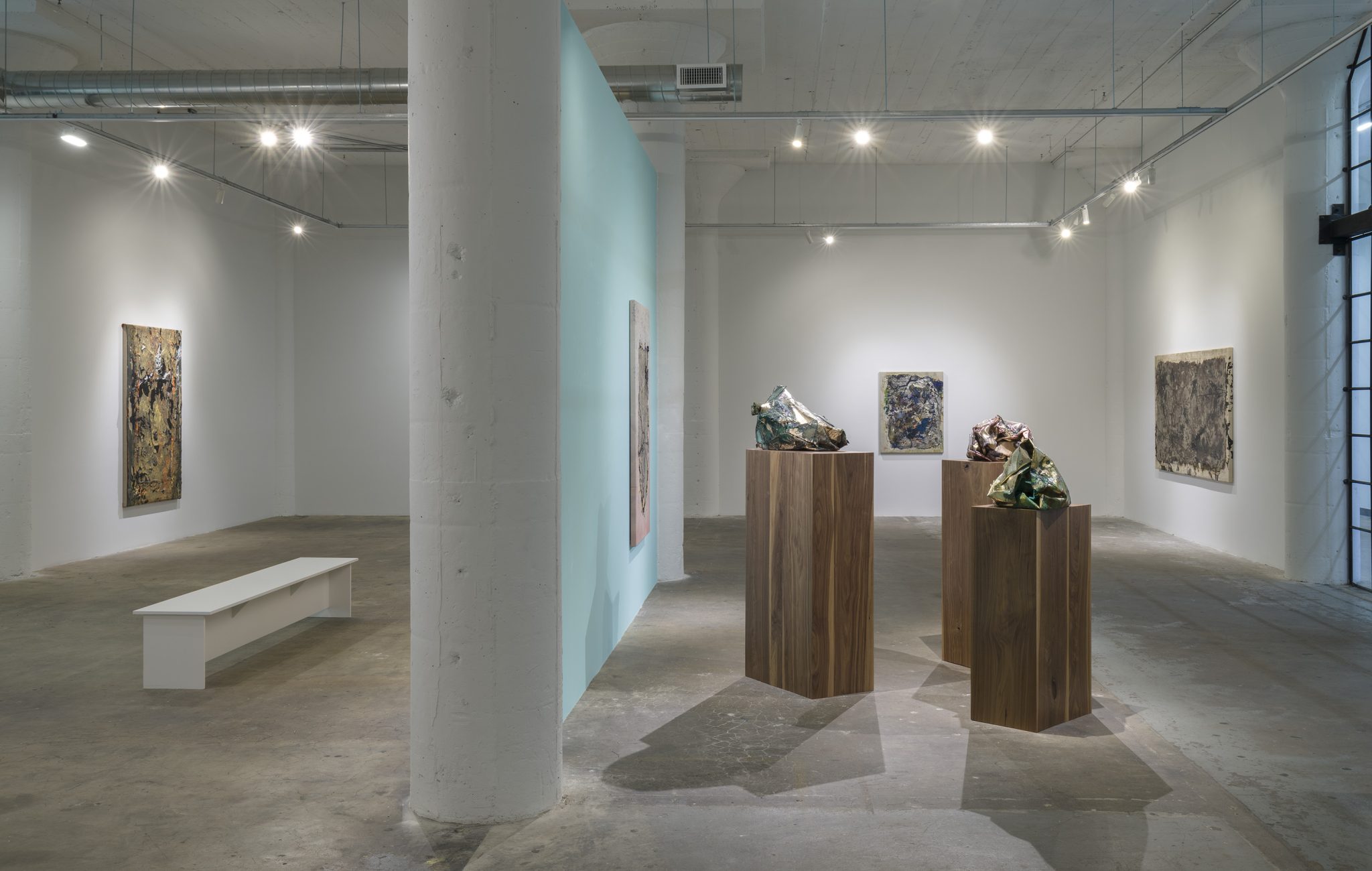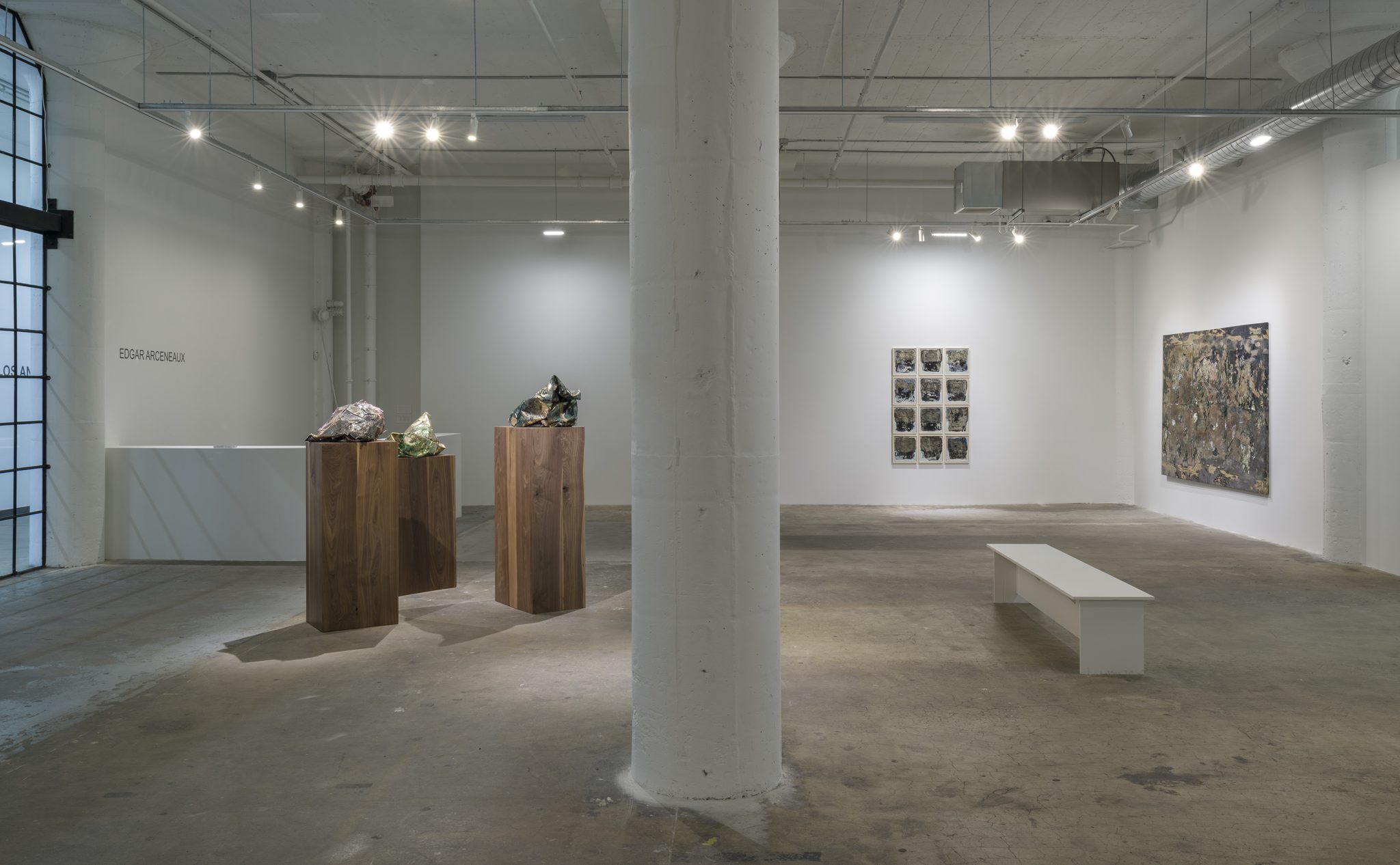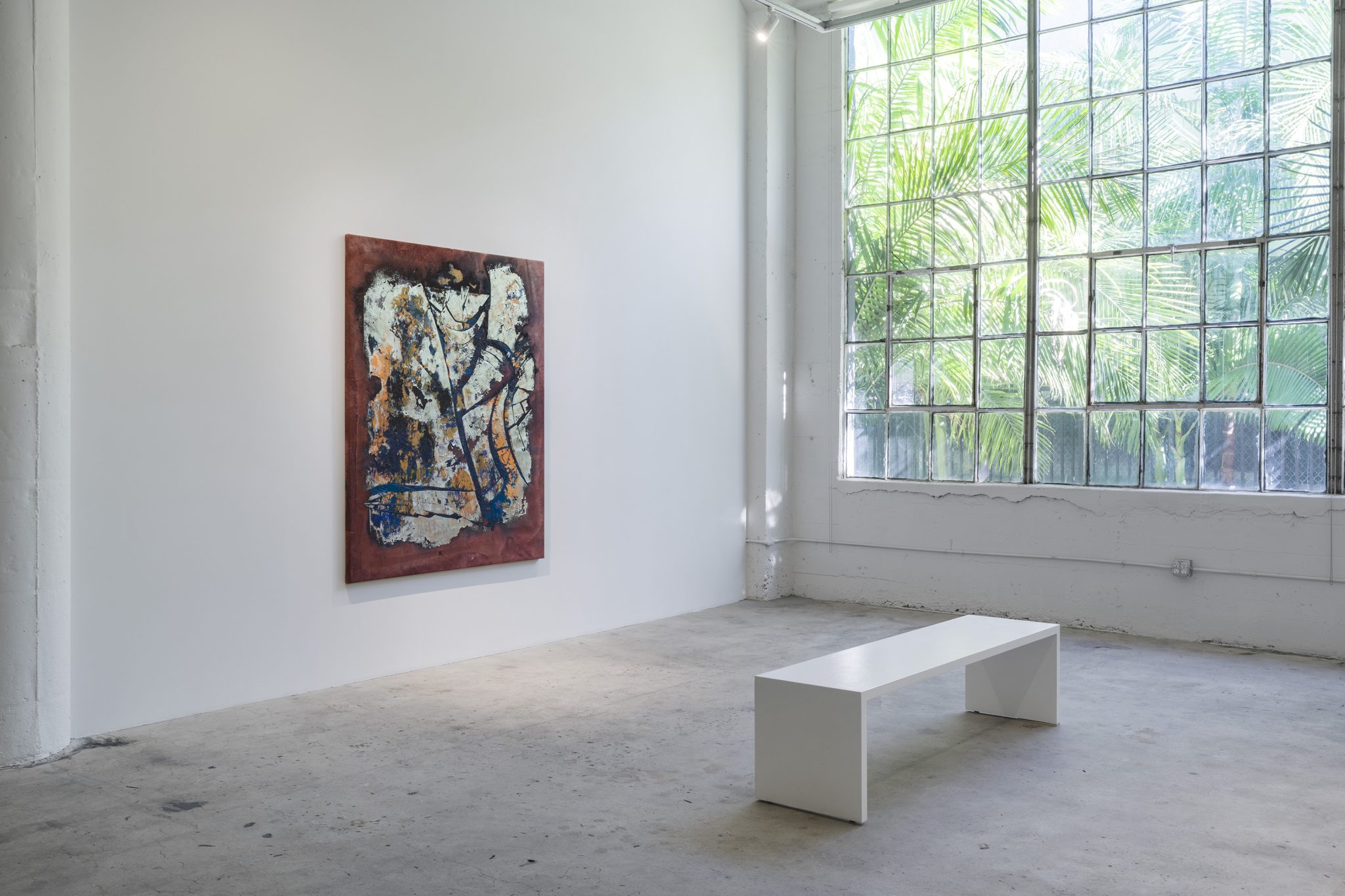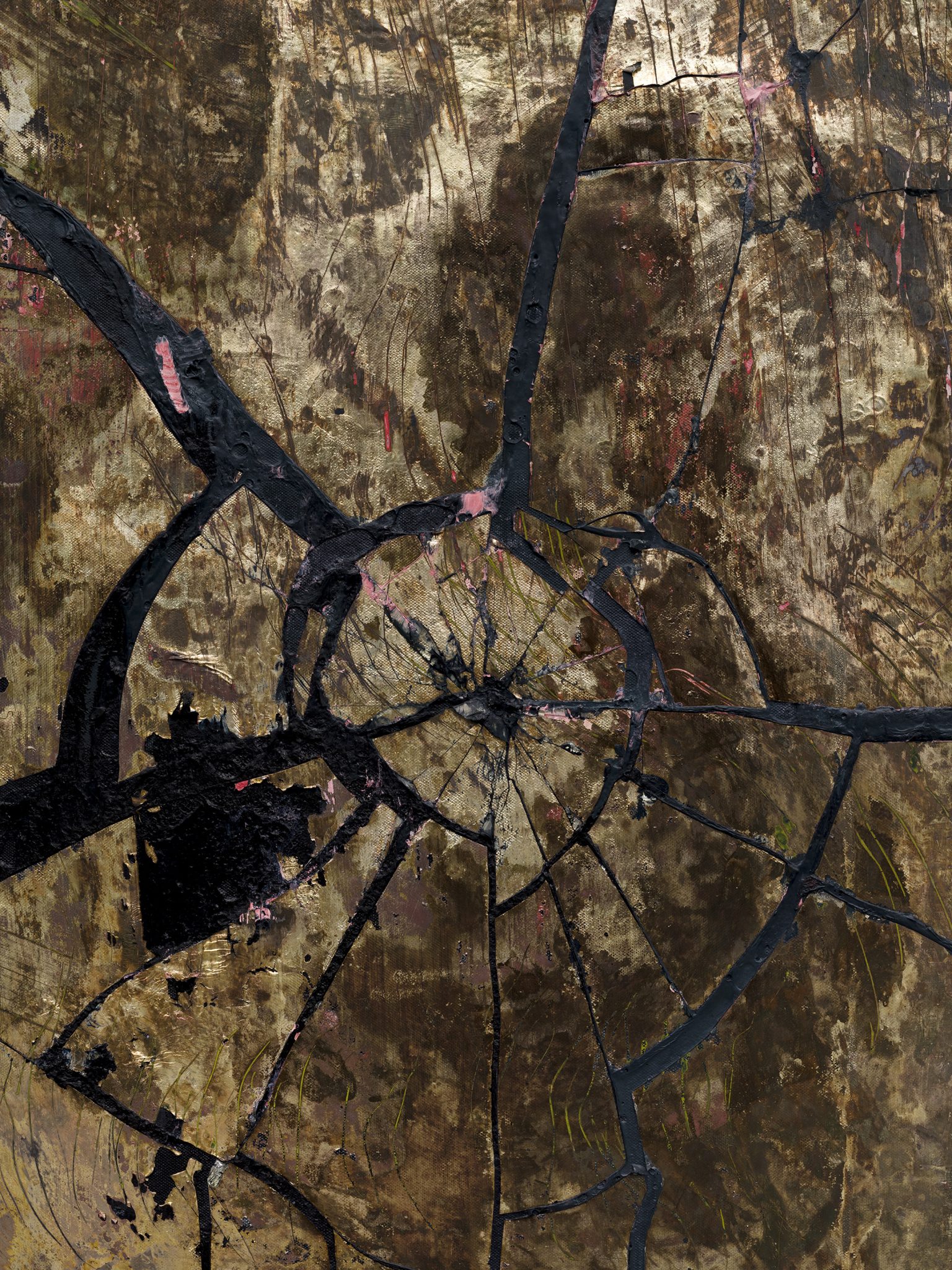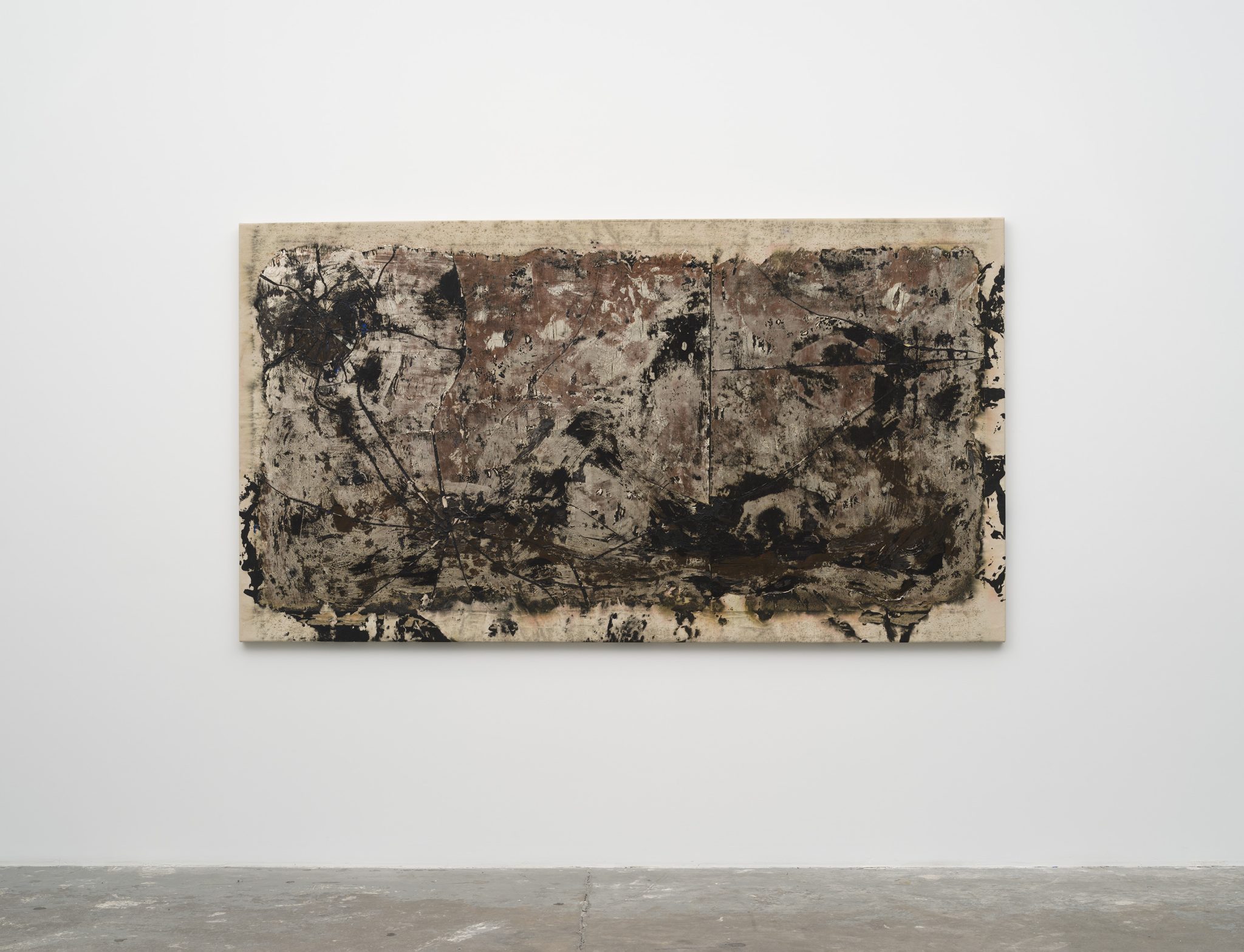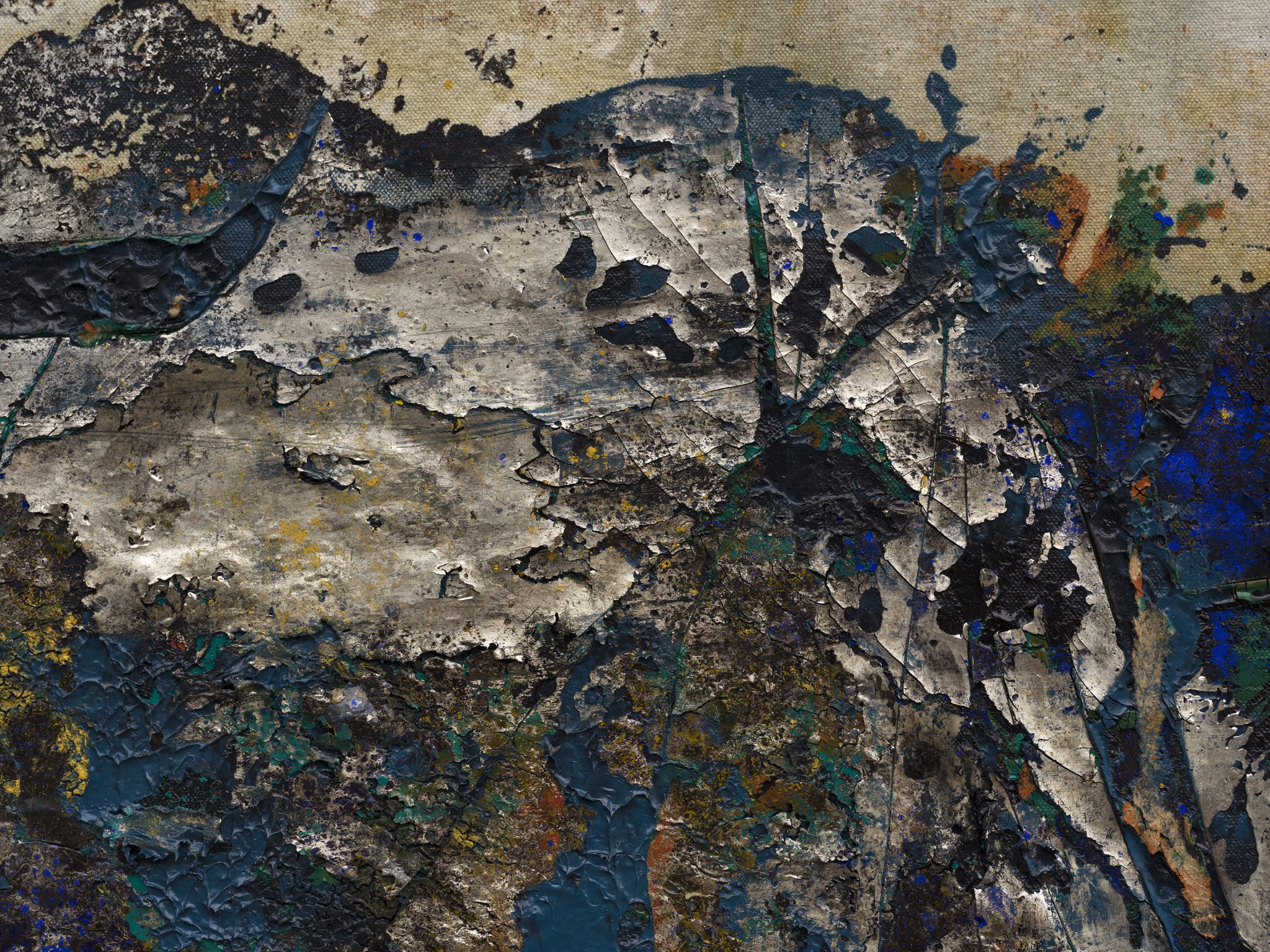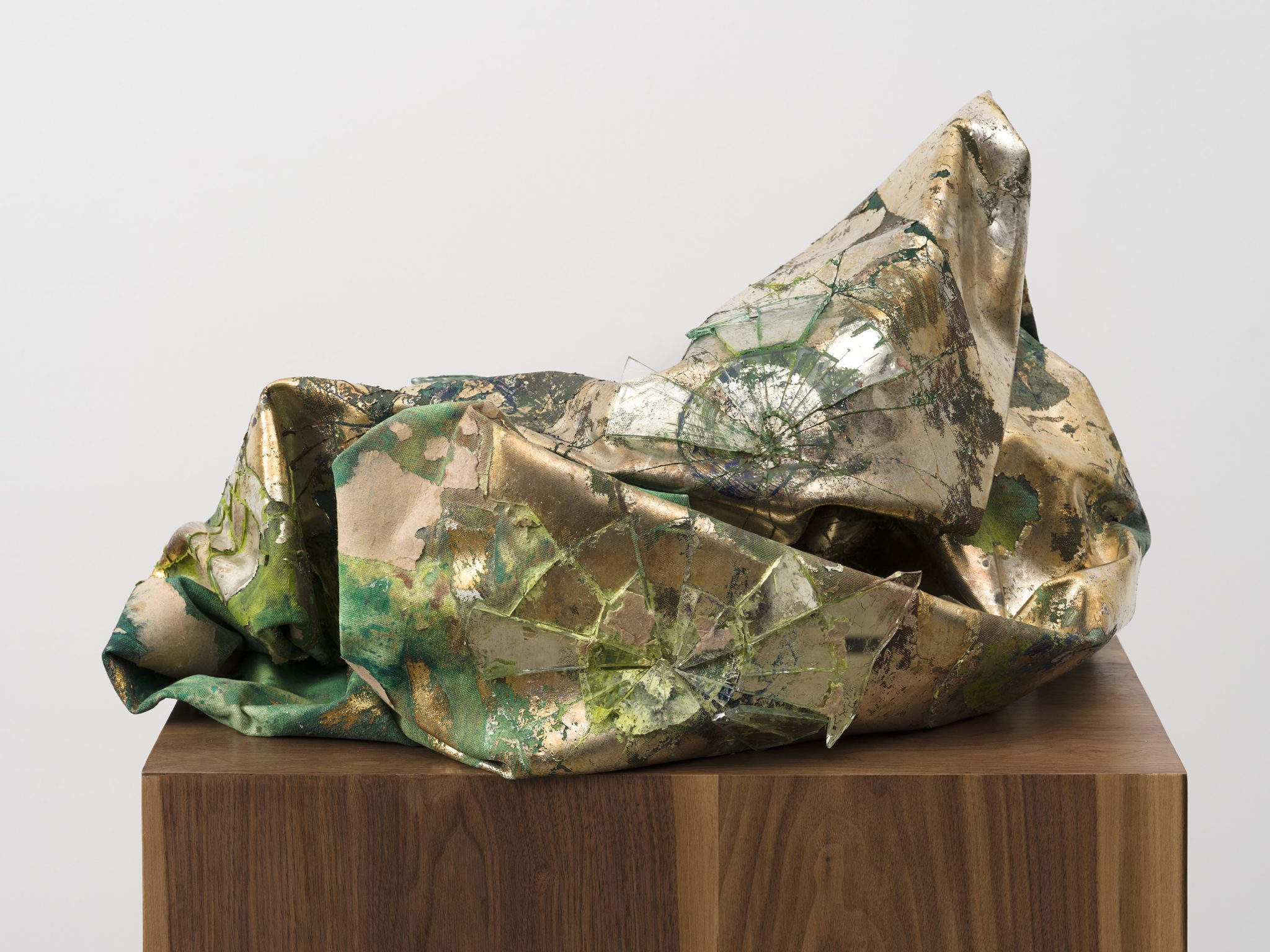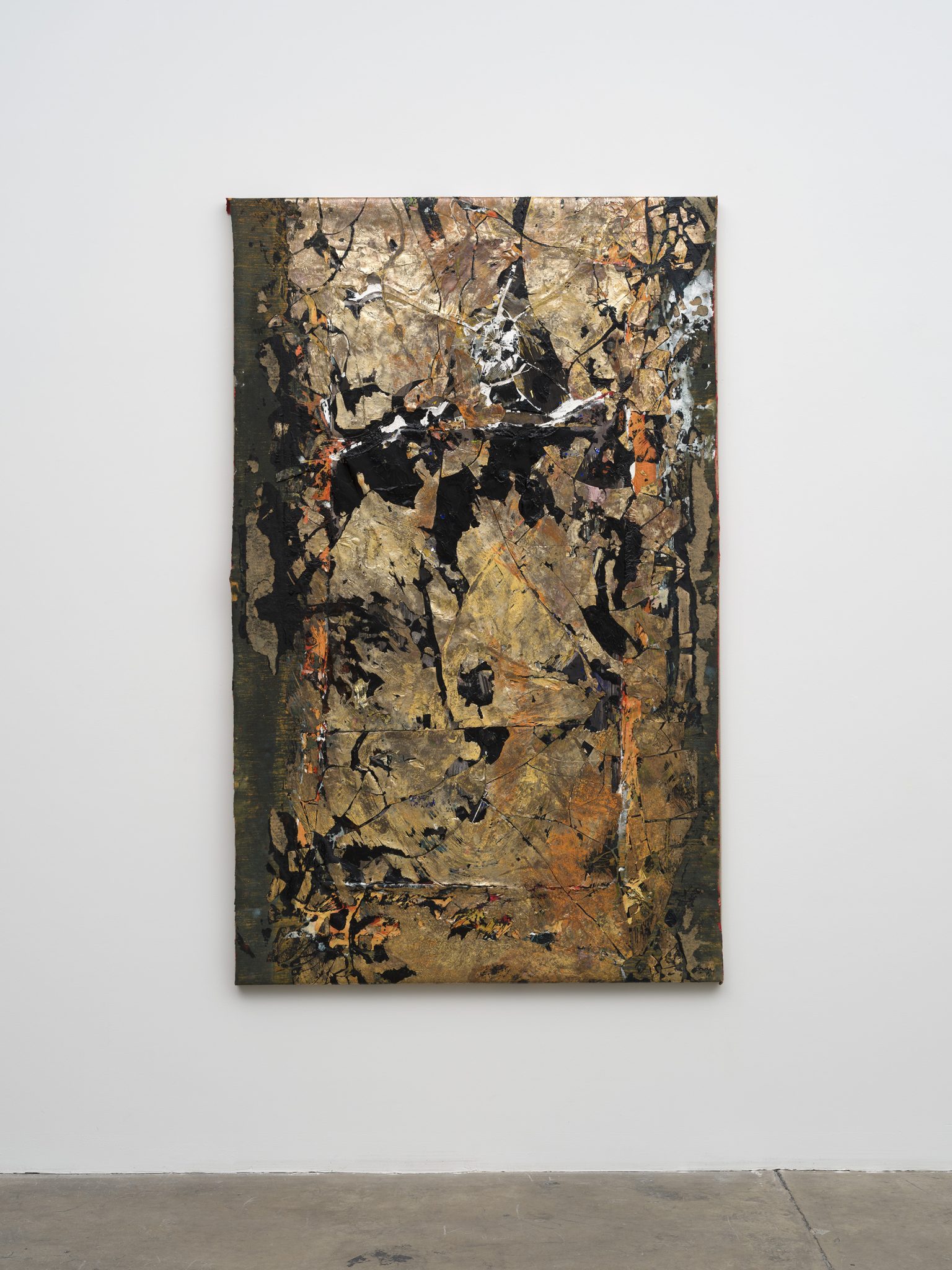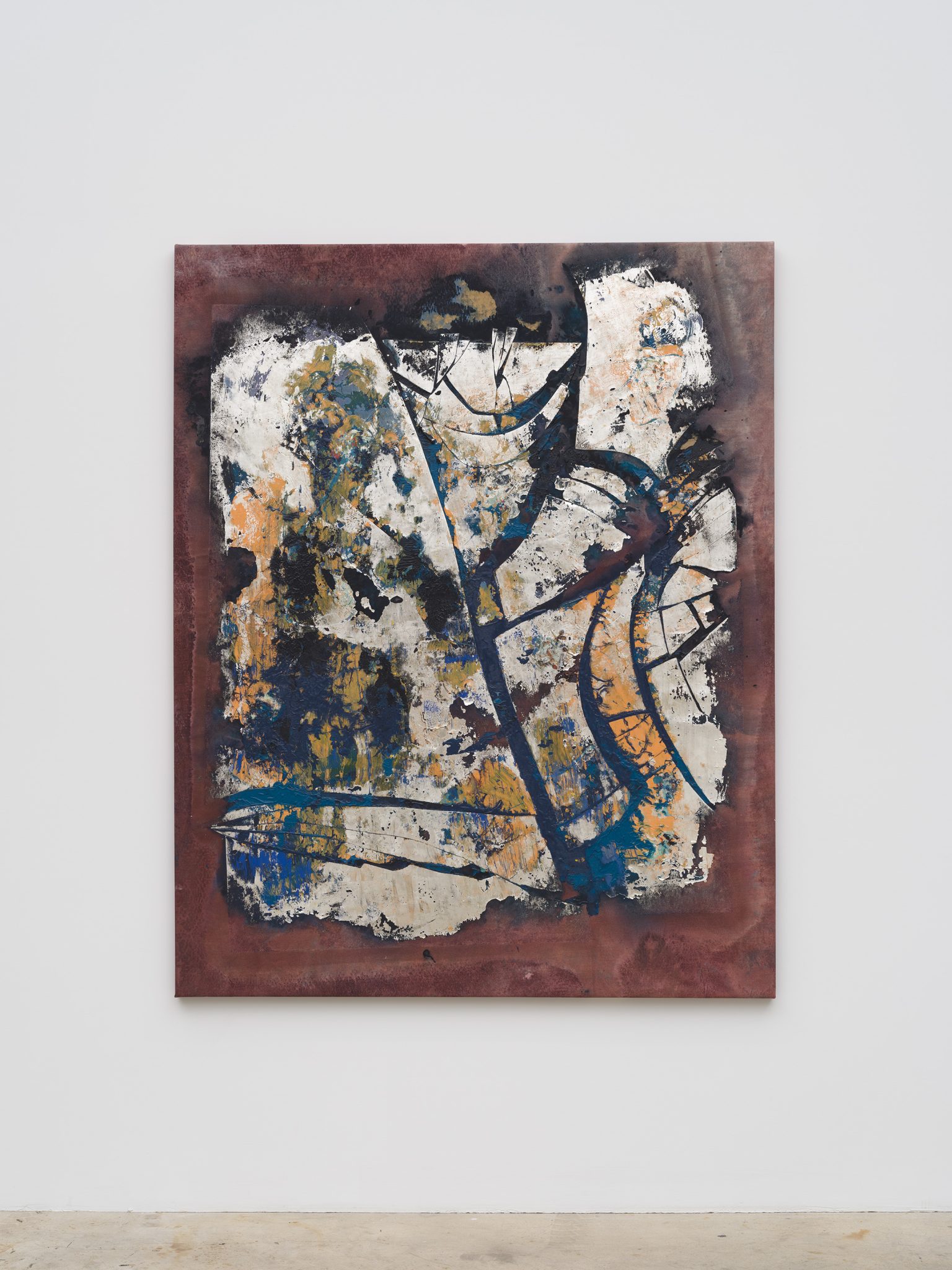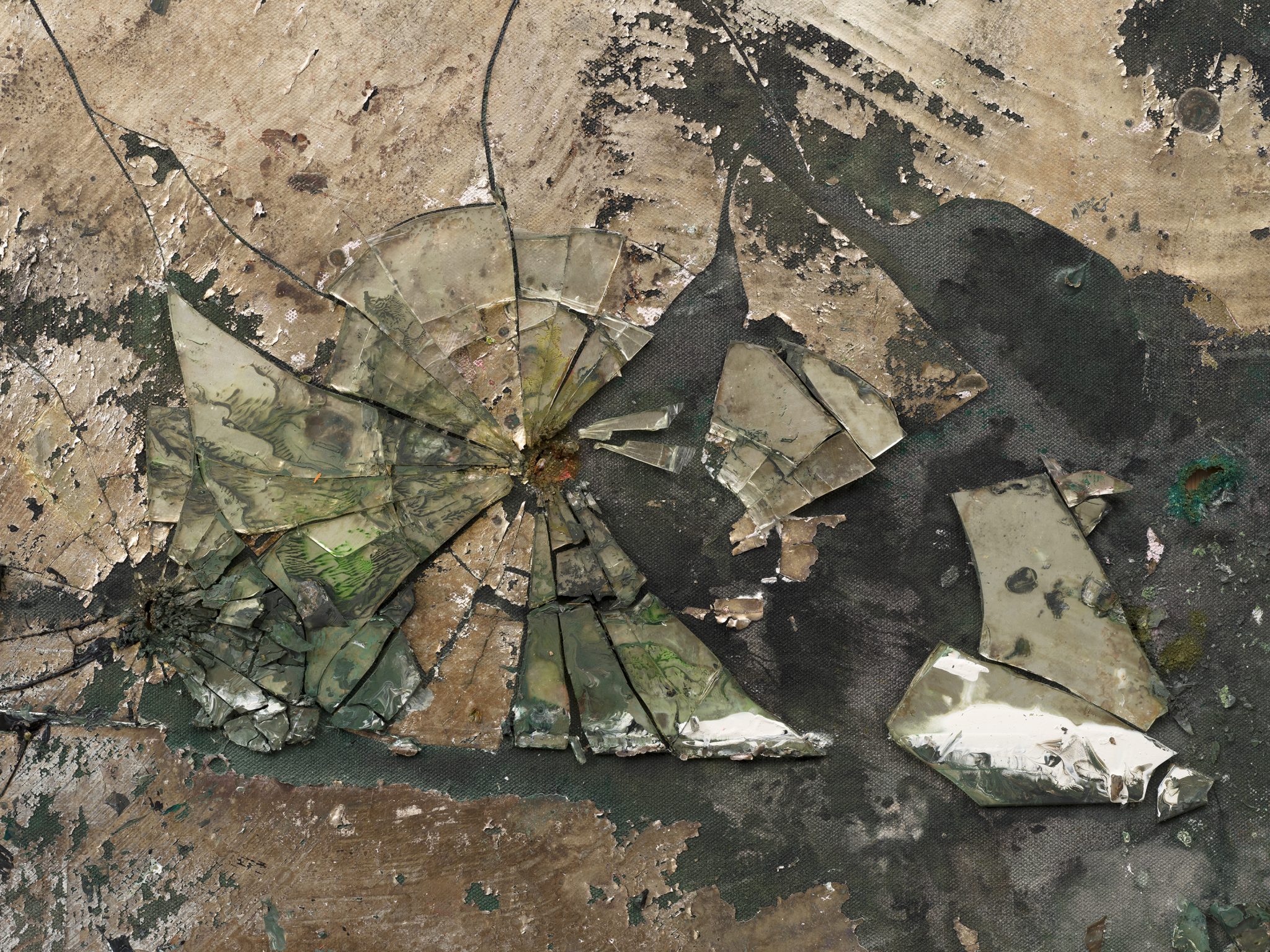

Vielmetter Los Angeles is pleased to present Skinning the Mirror, the gallery’s eleventh solo presentation by Los Angeles-based artist Edgar Arceneaux, featuring a cohesive installation of multi-media paintings and sculpture.
“Skinning the Mirror #14,” 2021
Silver nitrate, acrylic paint, paper, and glass on canvas
71 ¹⁄₄" x 39 ¹⁄₂" x 2" [HxWxD] (180.98 x 100.33 x 5.08 cm)
Inventory #ARC650
Courtesy of the artist and Vielmetter Los Angeles
Photo credit: Jeff McLane

“Skinning the Mirror #14,” 2021
Silver nitrate, acrylic paint, paper, and glass on canvas
71 ¹⁄₄" x 39 ¹⁄₂" x 2" [HxWxD] (180.98 x 100.33 x 5.08 cm)
Inventory #ARC650
Courtesy of the artist and Vielmetter Los Angeles
Photo credit: Jeff McLane
“Skinning the Mirror #14,” 2021
Silver nitrate, acrylic paint, paper, and glass on canvas
71 ¹⁄₄" x 39 ¹⁄₂" x 2" [HxWxD] (180.98 x 100.33 x 5.08 cm)
Inventory #ARC650
Courtesy of the artist and Vielmetter Los Angeles
Photo credit: Jeff McLane
“Skinning the Mirror #14,” 2021
Silver nitrate, acrylic paint, paper, and glass on canvas
71 ¹⁄₄" x 39 ¹⁄₂" x 2" [HxWxD] (180.98 x 100.33 x 5.08 cm)
Inventory #ARC650
Courtesy of the artist and Vielmetter Los Angeles
Photo credit: Jeff McLane
On this recent series of material-based abstractions, art historian Julian Myers-Szupinska writes:
The matter of mirrors is central to Edgar Arceneaux’s new body of work. This is figuratively true—they are about mirrors and the self-relations they enable—and factually the case, as each artwork is derived from a found mirror. Through a strenuous process that is both chemical and physical, Arceneaux has decoupled the mirror’s reflective metal backing from its rigid glass substrate and imposed it onto loose canvas. That this is not a smooth or simple process is evident in the objects that result from it. The transfer is often rocky and incomplete—sometimes the transfer doesn’t take completely. And one witnesses across the ongoing series evidence of rippling, concussion-like impacts, where glass substrate broken along the way has impressed its fragmentation onto the distressed visual field. One sees, too, the layering of colors, black, rust, and toxic verdigris, that parse as gestural—even abstract.
“Skinning the Mirror #9,” 2021
Silver nitrate, acrylic paint, and glass on canvas
56" x 102" x 2" [HxWxD] (142.24 x 259.08 x 5.08 cm)
Inventory #ARC639
Courtesy of the artist and Vielmetter Los Angeles
Photo credit: Jeff McLane

“Skinning the Mirror #9,” 2021
Silver nitrate, acrylic paint, and glass on canvas
56" x 102" x 2" [HxWxD] (142.24 x 259.08 x 5.08 cm)
Inventory #ARC639
Courtesy of the artist and Vielmetter Los Angeles
Photo credit: Jeff McLane
“Skinning the Mirror #9,” 2021
Silver nitrate, acrylic paint, and glass on canvas
56" x 102" x 2" [HxWxD] (142.24 x 259.08 x 5.08 cm)
Inventory #ARC639
Courtesy of the artist and Vielmetter Los Angeles
Photo credit: Jeff McLane
“Skinning the Mirror #9,” 2021
Silver nitrate, acrylic paint, and glass on canvas
56" x 102" x 2" [HxWxD] (142.24 x 259.08 x 5.08 cm)
Inventory #ARC639
Courtesy of the artist and Vielmetter Los Angeles
Photo credit: Jeff McLane
You are currently viewing a placeholder content from Default. To access the actual content, click the button below. Please note that doing so will share data with third-party providers.
More Information
These are mirrors that have, as Arceneaux tells it, been “skinned,” as one might skin the carcass of a hunter’s prey. Something of the uncanny beauty and horror of this image persists in the works. These mirrors, once “alive,” are now “dead,” and their chemical viscera placed on view. Too, the loose-hung canvases convey the weird effect of the death-shroud, impressed with the holy image of the cadaver beneath. These associations, derived from our quasi-mystical sense of mirrors as the repositories of the bodies they once reflected, coexist with the works’ other, equally necessary states of being. They are, simultaneously, direct records of their own physical process of creation, and an estranged sort of abstraction, extruded with difficulty from the readymade object they once were. The objects demand we think all these things at once, in an unfolding loop: death, object, process, abstraction, process, object, death.
“Skinning the Mirror #35,” 2022
Silver nitrate, acrylic paint, glass, and leaf on canvas
45 ¹⁄₄" x 35" x 2" [HxWxD] (114.93 x 88.9 x 5.08 cm)
Inventory #ARC686
Courtesy of the artist and Vielmetter Los Angeles
Photo credit: Jeff McLane

“Skinning the Mirror #35,” 2022
Silver nitrate, acrylic paint, glass, and leaf on canvas
45 ¹⁄₄" x 35" x 2" [HxWxD] (114.93 x 88.9 x 5.08 cm)
Inventory #ARC686
Courtesy of the artist and Vielmetter Los Angeles
Photo credit: Jeff McLane
“Skinning the Mirror #35,” 2022
Silver nitrate, acrylic paint, glass, and leaf on canvas
45 ¹⁄₄" x 35" x 2" [HxWxD] (114.93 x 88.9 x 5.08 cm)
Inventory #ARC686
Courtesy of the artist and Vielmetter Los Angeles
Photo credit: Jeff McLane
You are currently viewing a placeholder content from Default. To access the actual content, click the button below. Please note that doing so will share data with third-party providers.
More Information
What is a mirror? A simple optical device designed to extend our view, it is among the oldest of human prosthetics, reaching back to the earliest human civilizations. And where other such items of the era—stone axes, wood bows—have faded from contemporary life, mirrors have, by contrast, insinuated themselves ever farther into our daily habits, our ways of knowing ourselves and our means of getting around. Mirrors are standard kit for modern bathrooms and bedrooms; they are attached by manufacturers to cars to help us drive. And as computers have developed, they have become ever more mirror-like. Boob-tube-like monitors gave way to cool black rectangles designed to capture our image and deliver it back to us yassified. In the process, mirrors have gained alongside their practical uses, a rich psychic dimension. Not for nothing did the psychoanalyst Jacques Lacan describe the moment of human subject formation in the event of self-recognition using the metaphor of the mirror, as the “mirror stage.”
“Skinning the Mirror #20,” 2021
Silver nitrate, acrylic paint, paper, glass, canvas
11 ¹⁄₄" x 20 ¹⁄₂" x 22 ¹⁄₄" [HxWxD] (28.57 x 52.07 x 56.51 cm) sculpture; 50" x 17 ¹⁄₂" x 20 ¹⁄₂" [HxWxD] (127 x 44.45 x 52.07 cm) pedestal
Inventory #ARC657
Courtesy of the artist and Vielmetter Los Angeles
Photo credit: Jeff McLane

“Skinning the Mirror #20,” 2021
Silver nitrate, acrylic paint, paper, glass, canvas
11 ¹⁄₄" x 20 ¹⁄₂" x 22 ¹⁄₄" [HxWxD] (28.57 x 52.07 x 56.51 cm) sculpture; 50" x 17 ¹⁄₂" x 20 ¹⁄₂" [HxWxD] (127 x 44.45 x 52.07 cm) pedestal
Inventory #ARC657
Courtesy of the artist and Vielmetter Los Angeles
Photo credit: Jeff McLane
“Skinning the Mirror #20,” 2021
Silver nitrate, acrylic paint, paper, glass, canvas
11 ¹⁄₄" x 20 ¹⁄₂" x 22 ¹⁄₄" [HxWxD] (28.57 x 52.07 x 56.51 cm) sculpture; 50" x 17 ¹⁄₂" x 20 ¹⁄₂" [HxWxD] (127 x 44.45 x 52.07 cm) pedestal
Inventory #ARC657
Courtesy of the artist and Vielmetter Los Angeles
Photo credit: Jeff McLane
“Skinning the Mirror #20,” 2021
Silver nitrate, acrylic paint, paper, glass, canvas
11 ¹⁄₄" x 20 ¹⁄₂" x 22 ¹⁄₄" [HxWxD] (28.57 x 52.07 x 56.51 cm) sculpture; 50" x 17 ¹⁄₂" x 20 ¹⁄₂" [HxWxD] (127 x 44.45 x 52.07 cm) pedestal
Inventory #ARC657
Courtesy of the artist and Vielmetter Los Angeles
Photo credit: Jeff McLane
“Skinning the Mirror #20,” 2021
Silver nitrate, acrylic paint, paper, glass, canvas
11 ¹⁄₄" x 20 ¹⁄₂" x 22 ¹⁄₄" [HxWxD] (28.57 x 52.07 x 56.51 cm) sculpture; 50" x 17 ¹⁄₂" x 20 ¹⁄₂" [HxWxD] (127 x 44.45 x 52.07 cm) pedestal
Inventory #ARC657
Courtesy of the artist and Vielmetter Los Angeles
Photo credit: Jeff McLane
“Skinning the Mirror #21,” 2021
Silver nitrate, acrylic paint, paper, glass, canvas
15" x 16" x 25" [HxWxD] (38.1 x 40.64 x 63.5 cm) sculpture; 53" x 26 ¹⁄₂" x 17" [HxWxD] (134.62 x 67.31 x 43.18 cm) pedestal
Inventory #ARC658
Courtesy of the artist and Vielmetter Los Angeles
Photo credit: Jeff McLane

“Skinning the Mirror #21,” 2021
Silver nitrate, acrylic paint, paper, glass, canvas
15" x 16" x 25" [HxWxD] (38.1 x 40.64 x 63.5 cm) sculpture; 53" x 26 ¹⁄₂" x 17" [HxWxD] (134.62 x 67.31 x 43.18 cm) pedestal
Inventory #ARC658
Courtesy of the artist and Vielmetter Los Angeles
Photo credit: Jeff McLane
“Skinning the Mirror #21,” 2021
Silver nitrate, acrylic paint, paper, glass, canvas
15" x 16" x 25" [HxWxD] (38.1 x 40.64 x 63.5 cm) sculpture; 53" x 26 ¹⁄₂" x 17" [HxWxD] (134.62 x 67.31 x 43.18 cm) pedestal
Inventory #ARC658
Courtesy of the artist and Vielmetter Los Angeles
Photo credit: Jeff McLane
“Skinning the Mirror #21,” 2021
Silver nitrate, acrylic paint, paper, glass, canvas
15" x 16" x 25" [HxWxD] (38.1 x 40.64 x 63.5 cm) sculpture; 53" x 26 ¹⁄₂" x 17" [HxWxD] (134.62 x 67.31 x 43.18 cm) pedestal
Inventory #ARC658
Courtesy of the artist and Vielmetter Los Angeles
Photo credit: Jeff McLane
“Skinning the Mirror #21,” 2021
Silver nitrate, acrylic paint, paper, glass, canvas
15" x 16" x 25" [HxWxD] (38.1 x 40.64 x 63.5 cm) sculpture; 53" x 26 ¹⁄₂" x 17" [HxWxD] (134.62 x 67.31 x 43.18 cm) pedestal
Inventory #ARC658
Courtesy of the artist and Vielmetter Los Angeles
Photo credit: Jeff McLane
“Skinning the Mirror #23,” 2021
Silver nitrate, acrylic paint, paper, glass, canvas
13 ³⁄₄" x 27 ¹⁄₄" x 17" [HxWxD] (34.92 x 69.21 x 43.18 cm) sculpture; 43" x 14 ¹⁄₂" x 23" [HxWxD] (109.22 x 36.83 x 58.42 cm) pedestal
Inventory #ARC659
Courtesy of the artist and Vielmetter Los Angeles
Photo credit: Jeff McLane

“Skinning the Mirror #23,” 2021
Silver nitrate, acrylic paint, paper, glass, canvas
13 ³⁄₄" x 27 ¹⁄₄" x 17" [HxWxD] (34.92 x 69.21 x 43.18 cm) sculpture; 43" x 14 ¹⁄₂" x 23" [HxWxD] (109.22 x 36.83 x 58.42 cm) pedestal
Inventory #ARC659
Courtesy of the artist and Vielmetter Los Angeles
Photo credit: Jeff McLane
“Skinning the Mirror #23,” 2021
Silver nitrate, acrylic paint, paper, glass, canvas
13 ³⁄₄" x 27 ¹⁄₄" x 17" [HxWxD] (34.92 x 69.21 x 43.18 cm) sculpture; 43" x 14 ¹⁄₂" x 23" [HxWxD] (109.22 x 36.83 x 58.42 cm) pedestal
Inventory #ARC659
Courtesy of the artist and Vielmetter Los Angeles
Photo credit: Jeff McLane
“Skinning the Mirror #23,” 2021
Silver nitrate, acrylic paint, paper, glass, canvas
13 ³⁄₄" x 27 ¹⁄₄" x 17" [HxWxD] (34.92 x 69.21 x 43.18 cm) sculpture; 43" x 14 ¹⁄₂" x 23" [HxWxD] (109.22 x 36.83 x 58.42 cm) pedestal
Inventory #ARC659
Courtesy of the artist and Vielmetter Los Angeles
Photo credit: Jeff McLane
“Skinning the Mirror #23,” 2021
Silver nitrate, acrylic paint, paper, glass, canvas
13 ³⁄₄" x 27 ¹⁄₄" x 17" [HxWxD] (34.92 x 69.21 x 43.18 cm) sculpture; 43" x 14 ¹⁄₂" x 23" [HxWxD] (109.22 x 36.83 x 58.42 cm) pedestal
Inventory #ARC659
Courtesy of the artist and Vielmetter Los Angeles
Photo credit: Jeff McLane
Glass shards, mirrors, and disfigurement have appeared throughout Arceneaux’s extensive practice, as metaphors for the fragmentary nature of self-understanding and the incompleteness of historical narratives. But where earlier works have relied on building up conceptual plays between existing historical signs—with the mirror as a volatile form of ambiguity inside that play—here, in these new works on canvas, the ambiguity takes center stage. The Skinning the Mirror works disruptively cast us into a prehistorical, pre-subjective ooze, and leave us gazing at the image that is reflected back at us when the mirror loses its function—when it fails to confirm our wholeness, our normalcy, our place in the world, the cherished images of ourselves.
“Skinning The Mirror #33,” 2021
Silver nitrate, acrylic paint, paper, glass on canvas, mounted on linen panel
78 ¹⁄₂" x 49" x 2 ³⁄₄" [HxWxD] (199.39 x 124.46 x 6.99 cm)
Inventory #ARC662
Courtesy of the artist and Vielmetter Los Angeles
Photo credit: Jeff McLane

“Skinning The Mirror #33,” 2021
Silver nitrate, acrylic paint, paper, glass on canvas, mounted on linen panel
78 ¹⁄₂" x 49" x 2 ³⁄₄" [HxWxD] (199.39 x 124.46 x 6.99 cm)
Inventory #ARC662
Courtesy of the artist and Vielmetter Los Angeles
Photo credit: Jeff McLane
“Skinning The Mirror #33,” 2021
Silver nitrate, acrylic paint, paper, glass on canvas, mounted on linen panel
78 ¹⁄₂" x 49" x 2 ³⁄₄" [HxWxD] (199.39 x 124.46 x 6.99 cm)
Inventory #ARC662
Courtesy of the artist and Vielmetter Los Angeles
Photo credit: Jeff McLane
“Skinning The Mirror #33,” 2021
Silver nitrate, acrylic paint, paper, glass on canvas, mounted on linen panel
78 ¹⁄₂" x 49" x 2 ³⁄₄" [HxWxD] (199.39 x 124.46 x 6.99 cm)
Inventory #ARC662
Courtesy of the artist and Vielmetter Los Angeles
Photo credit: Jeff McLane
You are currently viewing a placeholder content from Default. To access the actual content, click the button below. Please note that doing so will share data with third-party providers.
More Information“Skinning the Mirror #36 diptych,” 2021
Silver nitrate, acrylic paint, glass on canvas
101 ¹⁄₄" x 160 ¹⁄₂" x 3 ³⁄₄" [HxWxD] (257.17 x 407.67 x 9.52 cm) overall; 101 ¹⁄₄" x 80 ¹⁄₄" x 3 ³⁄₄" [HxWxD] (257.17 x 203.83 x 9.52 cm) left side; 101 ¹⁄₄" x 80 ¹⁄₄" x 3 ³⁄₄" [HxWxD] (257.17 x 203.83 x 9.52 cm) right side
Inventory #ARC665
Courtesy of the artist and Vielmetter Los Angeles
Photo credit: Jeff McLane

“Skinning the Mirror #36 diptych,” 2021
Silver nitrate, acrylic paint, glass on canvas
101 ¹⁄₄" x 160 ¹⁄₂" x 3 ³⁄₄" [HxWxD] (257.17 x 407.67 x 9.52 cm) overall; 101 ¹⁄₄" x 80 ¹⁄₄" x 3 ³⁄₄" [HxWxD] (257.17 x 203.83 x 9.52 cm) left side; 101 ¹⁄₄" x 80 ¹⁄₄" x 3 ³⁄₄" [HxWxD] (257.17 x 203.83 x 9.52 cm) right side
Inventory #ARC665
Courtesy of the artist and Vielmetter Los Angeles
Photo credit: Jeff McLane
“Skinning the Mirror #36 diptych,” 2021
Silver nitrate, acrylic paint, glass on canvas
101 ¹⁄₄" x 160 ¹⁄₂" x 3 ³⁄₄" [HxWxD] (257.17 x 407.67 x 9.52 cm) overall; 101 ¹⁄₄" x 80 ¹⁄₄" x 3 ³⁄₄" [HxWxD] (257.17 x 203.83 x 9.52 cm) left side; 101 ¹⁄₄" x 80 ¹⁄₄" x 3 ³⁄₄" [HxWxD] (257.17 x 203.83 x 9.52 cm) right side
Inventory #ARC665
Courtesy of the artist and Vielmetter Los Angeles
Photo credit: Jeff McLane
“Skinning the Mirror #36 diptych,” 2021
Silver nitrate, acrylic paint, glass on canvas
101 ¹⁄₄" x 160 ¹⁄₂" x 3 ³⁄₄" [HxWxD] (257.17 x 407.67 x 9.52 cm) overall; 101 ¹⁄₄" x 80 ¹⁄₄" x 3 ³⁄₄" [HxWxD] (257.17 x 203.83 x 9.52 cm) left side; 101 ¹⁄₄" x 80 ¹⁄₄" x 3 ³⁄₄" [HxWxD] (257.17 x 203.83 x 9.52 cm) right side
Inventory #ARC665
Courtesy of the artist and Vielmetter Los Angeles
Photo credit: Jeff McLane
“Skinning the Mirror #36 diptych,” 2021
Silver nitrate, acrylic paint, glass on canvas
101 ¹⁄₄" x 160 ¹⁄₂" x 3 ³⁄₄" [HxWxD] (257.17 x 407.67 x 9.52 cm) overall; 101 ¹⁄₄" x 80 ¹⁄₄" x 3 ³⁄₄" [HxWxD] (257.17 x 203.83 x 9.52 cm) left side; 101 ¹⁄₄" x 80 ¹⁄₄" x 3 ³⁄₄" [HxWxD] (257.17 x 203.83 x 9.52 cm) right side
Inventory #ARC665
Courtesy of the artist and Vielmetter Los Angeles
Photo credit: Jeff McLane
“Skinning the Mirror #37,” 2021
Silver nitrate, acrylic paint, and glass on canvas
73" x 58" x 1 ³⁄₄" [HxWxD] (185.42 x 147.32 x 4.45 cm)
Inventory #ARC672
Courtesy of the artist and Vielmetter Los Angeles
Photo credit: Jeff McLane

“Skinning the Mirror #37,” 2021
Silver nitrate, acrylic paint, and glass on canvas
73" x 58" x 1 ³⁄₄" [HxWxD] (185.42 x 147.32 x 4.45 cm)
Inventory #ARC672
Courtesy of the artist and Vielmetter Los Angeles
Photo credit: Jeff McLane
“Skinning the Mirror #37,” 2021
Silver nitrate, acrylic paint, and glass on canvas
73" x 58" x 1 ³⁄₄" [HxWxD] (185.42 x 147.32 x 4.45 cm)
Inventory #ARC672
Courtesy of the artist and Vielmetter Los Angeles
Photo credit: Jeff McLane
“Skinning the Mirror #37,” 2021
Silver nitrate, acrylic paint, and glass on canvas
73" x 58" x 1 ³⁄₄" [HxWxD] (185.42 x 147.32 x 4.45 cm)
Inventory #ARC672
Courtesy of the artist and Vielmetter Los Angeles
Photo credit: Jeff McLane
You are currently viewing a placeholder content from Default. To access the actual content, click the button below. Please note that doing so will share data with third-party providers.
More Information“Skinning the Mirror #38,” 2021
Silver nitrate, acrylic paint, and glass on canvas
73" x 58" x 1 ¹⁄₂" [HxWxD] (185.42 x 147.32 x 3.81 cm)
Inventory #ARC673
Courtesy of the artist and Vielmetter Los Angeles
Photo credit: Jeff McLane

“Skinning the Mirror #38,” 2021
Silver nitrate, acrylic paint, and glass on canvas
73" x 58" x 1 ¹⁄₂" [HxWxD] (185.42 x 147.32 x 3.81 cm)
Inventory #ARC673
Courtesy of the artist and Vielmetter Los Angeles
Photo credit: Jeff McLane
“Skinning the Mirror #38,” 2021
Silver nitrate, acrylic paint, and glass on canvas
73" x 58" x 1 ¹⁄₂" [HxWxD] (185.42 x 147.32 x 3.81 cm)
Inventory #ARC673
Courtesy of the artist and Vielmetter Los Angeles
Photo credit: Jeff McLane
“Skinning the Mirror #38,” 2021
Silver nitrate, acrylic paint, and glass on canvas
73" x 58" x 1 ¹⁄₂" [HxWxD] (185.42 x 147.32 x 3.81 cm)
Inventory #ARC673
Courtesy of the artist and Vielmetter Los Angeles
Photo credit: Jeff McLane
You are currently viewing a placeholder content from Default. To access the actual content, click the button below. Please note that doing so will share data with third-party providers.
More Information“Skinning the Mirror #25,” 2021
Silver nitrate, acrylic paint, paper, and glass on canvas
67" x 34" x 1 ³⁄₄" [HxWxD] (170.18 x 86.36 x 4.45 cm)
Inventory #ARC649
Courtesy of the artist and Vielmetter Los Angeles
Photo credit: Jeff McLane

“Skinning the Mirror #25,” 2021
Silver nitrate, acrylic paint, paper, and glass on canvas
67" x 34" x 1 ³⁄₄" [HxWxD] (170.18 x 86.36 x 4.45 cm)
Inventory #ARC649
Courtesy of the artist and Vielmetter Los Angeles
Photo credit: Jeff McLane
“Skinning the Mirror #25,” 2021
Silver nitrate, acrylic paint, paper, and glass on canvas
67" x 34" x 1 ³⁄₄" [HxWxD] (170.18 x 86.36 x 4.45 cm)
Inventory #ARC649
Courtesy of the artist and Vielmetter Los Angeles
Photo credit: Jeff McLane
“Skinning the Mirror #25,” 2021
Silver nitrate, acrylic paint, paper, and glass on canvas
67" x 34" x 1 ³⁄₄" [HxWxD] (170.18 x 86.36 x 4.45 cm)
Inventory #ARC649
Courtesy of the artist and Vielmetter Los Angeles
Photo credit: Jeff McLane
“Skinning the Mirror #24,” 2021
Silver nitrate, acrylic paint, paper, and glass on canvas
74" x 120 ¹⁄₄" x 2 ¹⁄₄" [HxWxD] (187.96 x 305.43 x 5.71 cm)
Inventory #ARC648
Courtesy of the artist and Vielmetter Los Angeles
Photo credit: Jeff McLane
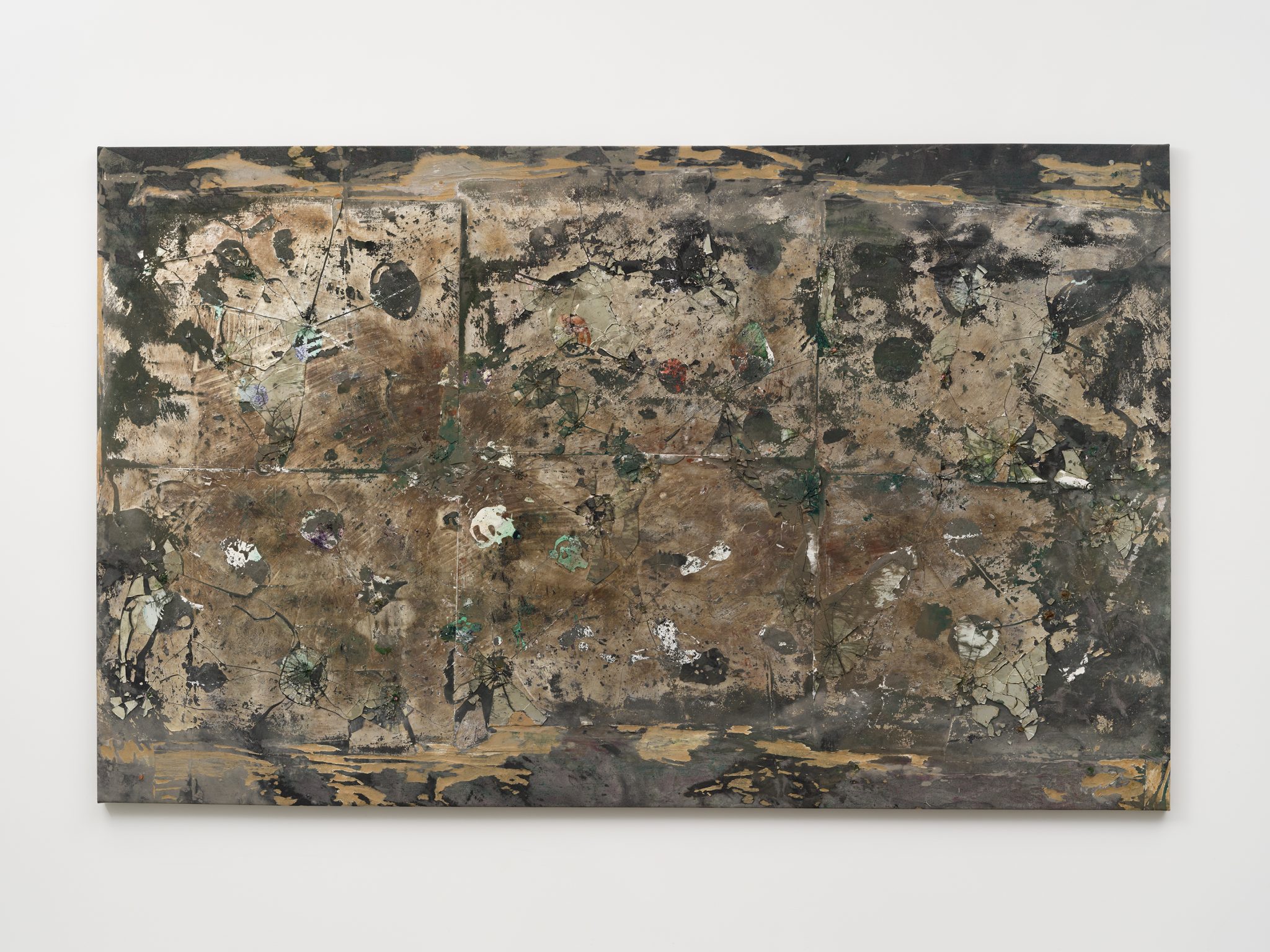
“Skinning the Mirror #24,” 2021
Silver nitrate, acrylic paint, paper, and glass on canvas
74" x 120 ¹⁄₄" x 2 ¹⁄₄" [HxWxD] (187.96 x 305.43 x 5.71 cm)
Inventory #ARC648
Courtesy of the artist and Vielmetter Los Angeles
Photo credit: Jeff McLane
“Skinning the Mirror #24,” 2021
Silver nitrate, acrylic paint, paper, and glass on canvas
74" x 120 ¹⁄₄" x 2 ¹⁄₄" [HxWxD] (187.96 x 305.43 x 5.71 cm)
Inventory #ARC648
Courtesy of the artist and Vielmetter Los Angeles
Photo credit: Jeff McLane
“Skinning the Mirror #24,” 2021
Silver nitrate, acrylic paint, paper, and glass on canvas
74" x 120 ¹⁄₄" x 2 ¹⁄₄" [HxWxD] (187.96 x 305.43 x 5.71 cm)
Inventory #ARC648
Courtesy of the artist and Vielmetter Los Angeles
Photo credit: Jeff McLane
“Skinning the Mirror #24,” 2021
Silver nitrate, acrylic paint, paper, and glass on canvas
74" x 120 ¹⁄₄" x 2 ¹⁄₄" [HxWxD] (187.96 x 305.43 x 5.71 cm)
Inventory #ARC648
Courtesy of the artist and Vielmetter Los Angeles
Photo credit: Jeff McLane
“Cohesion Sketches June 30th, 2021 #1-4,” 2021
Silver nitrate, acrylic paint on canvas
15 ¹⁄₂" x 12 ³⁄₄" [HxW] (39.36 x 32.38 cm) each
Courtesy of the artist and Vielmetter Los Angeles
Photo credit: Jeff McLane
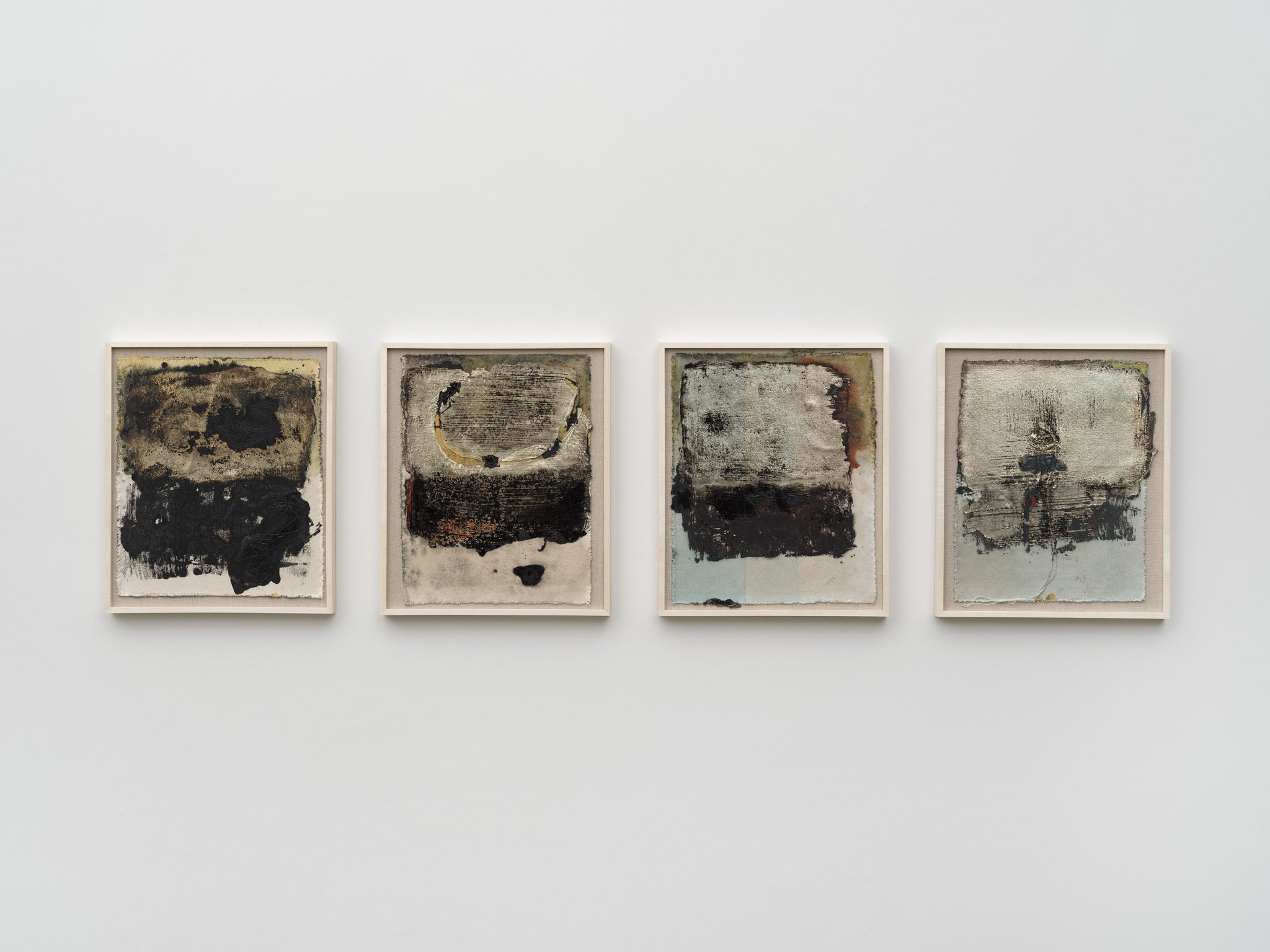
“Cohesion Sketches June 30th, 2021 #1-4,” 2021
Silver nitrate, acrylic paint on canvas
15 ¹⁄₂" x 12 ³⁄₄" [HxW] (39.36 x 32.38 cm) each
Courtesy of the artist and Vielmetter Los Angeles
Photo credit: Jeff McLane
“Cohesion Sketches December 11th, 2021 #1-12,” 2021
Silver nitrate, acrylic paint on canvas
14 ³⁄₄" x 12 ³⁄₄" [HxW] (37.46 x 32.38 cm) each
Courtesy of the artist and Vielmetter Los Angeles
Photo credit: Jeff McLane

“Cohesion Sketches December 11th, 2021 #1-12,” 2021
Silver nitrate, acrylic paint on canvas
14 ³⁄₄" x 12 ³⁄₄" [HxW] (37.46 x 32.38 cm) each
Courtesy of the artist and Vielmetter Los Angeles
Photo credit: Jeff McLane
All Videos by Xiaoyue Zhang.
About the Artist
Edgar Arceneaux (b. 1972, Los Angeles) works in the fields of drawing, sculpture, installation, performance, and video; often exploring connections between historical events and present-day truths. Arceneaux has had solo exhibitions at such institutions as The Kitchen, Studio Museum in Harlem, New York; the Vera List Center at MIT in Cambridge, Massachusetts; Hammer Museum, Los Angeles; and Museum für Gegenwartskunst in Basel, Switzerland; San Francisco Museum of Modern Art, San Francisco; Museum of Contemporary Art, Linz, Austria.
His work has also been presented at the Museum of Modern Art, Bronx Museum, Performa 15 and Whitney Museum, New York; Astrup Fearnley Museum of Art in Oslo, Norway; San Diego Museum of Contemporary Art, San Diego; Museum of Contemporary Art, Los Angeles; and MIT List Visual Arts Center, Cambridge, Massachusetts, among other venues.
Arceneaux’s work resides in such collections as the Whitney Museum, New York; Museum of Modern Art, New York; Hammer Museum, Los Angeles; Ludwig Museum, Cologne; Walker Art Center; Minneapolis Institute of Art; Orange County Museum of Art, and Los Angeles County Museum of Art. Arceneaux attended the California Institute of the Arts (MFA, 2001), Fachhochschule Aachen (2000), the Skowhegan School of Painting and Sculpture (1999), and Art Center College of Design (BFA, 1996).
A sneak peek of Arceneaux’s new play Boney Manilli will be presented as an outdoor performance at Vielmetter Los Angeles on February 18th, 2022 @ 7pm—and is scheduled to make its official US premiere in 2023 at UCLA’s Center for the Art of Performance. Arceneaux received the prestigious Mike Kelley Foundation Award in 2019 to support Boney Manilli and the COLA Individual Artist Fellowship in 2020. He currently serves on the Board of Directors at Creative Capital and is an Associate Professor of Art at the Roski School of Art and Design, USC.
About the Writer
Julian Myers-Szupinska is an art historian and editor whose essays have appeared in Afterall, Art Journal, Artforum, Documents, Fillip, Frieze, October, Tate Papers, exhibition catalogues, academic publications, and other venues. A scholar of contemporary art and exhibitions, Myers-Szupinska is founding faculty in the Department of Curatorial Practice at California College of the Arts, and was senior editor of The Exhibitionist, a journal of exhibition making, from 2014 to 2017. Myers-Szupinska earned a PhD in the History of Art at the University of California, Berkeley, and a BA at Cornell University.




